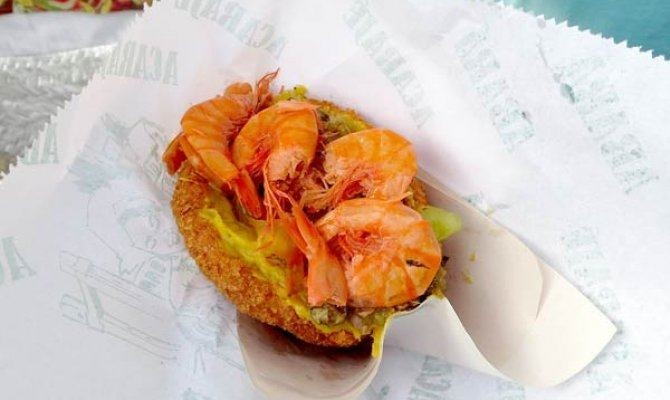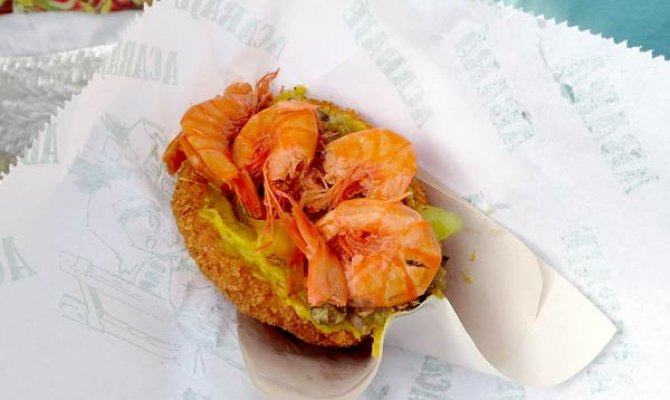The Ultimate Guide To Eating Street Food In Rio
Rio de Janeiro is one of the most diverse cities in the world; therefore, there is no such thing as "a typical dish." Our food integrates many influences from other countries, mostly the ones that have had an important part in our formation, like Portugal, Italy, and, surprisingly, Japan. Our food has Chinese and Arabic influences, too.
It's a puzzle of flavors, but even the pickiest of eaters will find their niche. Here a few tips for approaching the diverse flavors of Rio.
Eat Sushi on the Street
For those who can't stay away from sushi, sashimi, and other raw goods, Rio boasts some fascinating Japanese cuisine as interpreted by Brazilians. It's funny, because Brazil is not a country with a raw food culture, yet here we are, learning from the Japanese the craft of good sushi.
And, although there are plenty of Japanese restaurants, most of which run under an all-you-can-eat model, you'll find some of the best sushi right on the street.
Once upon a time, the only edible street foor was pastel, a fried dough with a filling, usually of ground meat, hearts of palm, mozarella, or, if sweet, guava paste or bananas. But an enterprising fishmonger named Arnaldo Barcellos saw a gap and started selling sushi and sashimi by the pound. Now, he runs a crew of 12 Japanese-trained sushi chefs for his Sushi Barcellos franchise, found at five different marketplaces — Ilha do Governador, Pechincha, Taquara, Grajau, and Andaraí.
Follow the Walking Tapioca
On the streets of Flamengo and Botafogo, there's a man who walks alone at night, carrying a cart with a stove. Even if the scene is a little scary, you don't have to be afraid of Arnaldo and his tapioca.
On weekdays, if there's a need for a warm and fuzzy feeling, a cozy comfort, tapioca is the only solution, and this little cart is your medicine. Arnaldo's preparation is fast and without frills; he lines his pan with a fine flour made of yuca that looks a little like a crêpe. The filling is salty or sweet: choose between cheese curd and ghee or guava paste, for example. The options are infinite.
Arnaldo's tapioca is one of the best — and cheapest — options for street food in Rio. His cart has no website and no fixed point, but he has been a fixture in the beachside neighborhoods of Flamengo and Botafogo for 15 years.
In his cart, you can also find some regional goods from the northeast, like cassava cake, ghee, organic honey, cheese curd, cashew nuts, and quebra queixo, a stiff candy made of molasses.
Eat Food at the Beach All Day
When Cariocas go to the beach, they stay there all day. Sometimes they even stick around well into the night; the fun never stops. There is a whole culinary culture that revolves around that day: beach food.
The basic training starts with a Globo biscuit: a sort of air-puffed donut made from tapioca flour that has both salty and sweet varieties. They are sold by vendors right on the beach and are crumbly and delicious — a perfect snack. Cariocas like to eat them with mate, a sweet tea that comes in a cup. It's a classic start to the day. Don't miss it.
At Ipanema Beach, you'll want to eat vegetarian sandwiches and vegetarian hamburgers from Hareburger, which you can buy on the beach or in one of their two locations in the city. Be prepared to wait in line.
Picolé do Morais on Leblon Beach sells ice pops that are definitely not only for children. They are homemade and fat-free, with no preservatives or artificial food coloring. Banana, pineapple, tangerine, and jackfruit are some of the (beautifully made) flavors.
At Barra da Tijuca Beach, you'll find the best esfihas, which are the Brazilian version of Arab pizza, a flatbread topped with ricotta, minced beef, or chicken and folded into a triangular shape. You won't have a hard time finding them: men dressed head-to-toe in white, like sheiks, sell them on the beach.
Hot Dogs Taste Better at 2 a.m.
Botafogo is a neighborhood in Rio with a lot of bars and nightclubs, and it's always helpful to have a spot to pig out after drinks and dancing, Oliveira has one of the best hot dogs in Rio, and it's open every day until 3 a.m. He's been at the same spot in Humaitá, near the Café do Largo, since 1995. Oliveira's hot dog has corn, peas and palha potato chips (potato chip sticks), which he claims to have created.
His customers come from everywhere, and even top artists stop to eat what is often called "the best hot dog in Rio." Oliveira wears a white dolman and a tall chef du cuisine hat, because, as he famously says, "I'm not everyone."
The key to his success? "The bread. It's 50 percent of the sandwich. Not even the best sausage saves an awful bread," says Oliveira.
Eat Acarajés in "Tropical Montmartre"
Santa Teresa is Rio's most bohemian neighborhood. Close to Lapa, sacred soil to everybody who loves the nightlife, Cariocas call "Santa" a tropical Montmartre for its slopes, beautiful architecture, and cool vibe. It's very French, yet still all Brazil. During Carnival, its streets are full of people dancing, drinking, and singing. When the days of revelry are past, this neighborhood has Rio's best acarajés — a fried dough made of beans stuffed with vatapá (spiced paste made from dried shrimp, cashews, and coconut milk) and caruru (okra, onion, shrimp, palm oil, and peanuts). It's served with more dried shrimp on top. You'll want to get them at Nega Teresa.
Drink Caipirinhas with Friends.
Lapa is, without a doubt, the favorite area in Rio for people who like to party. It has a lot of concerts, parties, clubs, and, of course, alcohol. There's a stand selling drinks at every corner, and you can't come to Rio and not taste a Caipirinha.
A national obsession, the caipirinha is a drink without frills. Cachaça, a cane distillate, meets sugar and a fruit. It's all mixed together, and that's it. Pure, glorious simplicity, although you'll also find creative combinations like mango with passionfruit, lemon with strawberry, and even a "capeta bahiano," with guarana powder, peanuts, cinnamon, condensed milk, pineapple, and vodka.
It's just not right to drink caipirinha alone. If you are flying solo in Rio, you can always find a pal — especially at Lapa, the best place to make friends.
Don't Let Its Funny Name Stop You From Eating Tacacá
Tacacá da Rose in Ilha do Governador serves tacacá, a typical Amazonian dish. It's a soup, served really hot, made with the herb jambú (a variety of paracress, or "toothache plant") and tucupi (a broth made with yuca). It's served with dried shrimps and a goo made of yuca.
Reading this description, you may ask yourself: Why would I eat something that makes my tongue go numb? Trust me, it's worth it. It's an experience.
This list was inspired by the travel guides Guia Carioca de Gastronomia de Rua, Volumes 1 and 2 by Sergio Bloch and Ines Garçoni.


